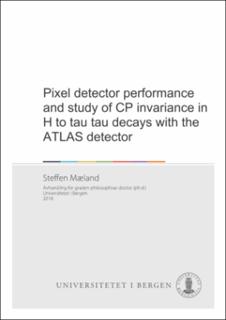| dc.description.abstract | Following its discovery by the ATLAS and CMS experiments in 2012, the Higgs boson has been studied in a multitude of decay modes. So far, its measured properties match very well with the predictions of the Standard Model of particle physics, which postulates the existence of a scalar field, to which all massive particles must couple. The scalar hypothesis can be tested by studying these couplings in detail. Several models predict an extension of the Higgs sector, which would involve a minimum of four additional Higgs bosons. These can potentially mix with each other, altering the kinematics of how the 125 GeV boson decays. This thesis presents a study of the potential for probing for new physics in Higgs decays into pairs of tau leptons. The correlation between the spin directions of the taus is reconstructed from the kinematics of the tau decay products, resulting in an observable angle, which is sensitive to the charge-parity (CP) state of the Higgs. Successful reconstruction of tau leptons rely on the information from the ATLAS tracking detectors. The innermost part of the detector, consisting of high-granularity pixel sensors, was before the beginning of 2015 operation upgraded with an additional pixel layer, the IBL, positioned extremely close to the collision point. Part of this thesis is devoted to the readout software which converts pixel detector output into data objects used by the event reconstruction algorithms. This software provides the mapping from the subdetector-specific module identification numbers, to the global ATLAS coordinate system. The intense conditions close to the collision point, under the record-breaking luminosity delivered by the LHC during the past three years of running, causes constant damage to the pixel sensors. To both ensure optimal operation of the detector, and to provide numbers to which simulations can be compared, a study has been carried out to measure the bias voltage required to fully deplete the sensors. Dedicated voltage scans have been performed at several occasions, to find the evolution of the depletion voltage over time. | en_US |
